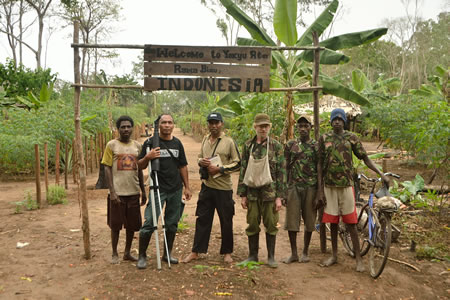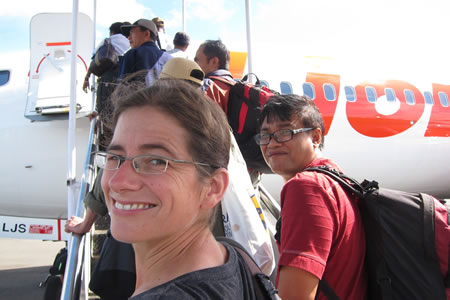English | Dutch |
|
| Our second journey to Papua | |
Kuala Lumpur (Malaysia) to Sentani (Indonesia), September 2012
|
|
| |
|
Our second journey to Papua started with the flight from Kuala Lumpur in Malaysia to the Indonesian capital Jakarta. We arrived in the afternoon, and we booked already in advance the flight to Jayapura for the same evening. The flight with Lion Air took us through the night via Makassar to Jayapura, the main city of the Indonesian province Papua. We arrived at 6 o’clock in the morning and we first checked in in a small hotel before we headed to the local police station. For most destinations in Papua, foreign travellers need a so called ‘surat jalan’ (travel permit), which is generally easy to get for the most usual destinations. Papua is still a problem area within the Indonesian archipelago because of the fact that the authentic Papuan people still prefer independence above being part of the Indonesian republic. That’s why the Indonesian government wants to know everything about what’s going on in this remote province, including the travel behaviour of foreigners. It is a 10-minute ojek ride (motorcycle taxi) to the Polres station and it didn’t take any effort to get our travel permit for all the destinations we planned to visit. |
|
 |
|
Waiting on Jakarta airport for the flight to Papua |
|
We spent the remaining part of the day in the small and dusty town of Sentani, roughly 30 kilometres west of Jayapura. Sentani is the town where the airport of Jayapura is located, and for this reason Sentani is a much more practical place to stay (if you need to use the airport once in a while). Sentani has all the facilities most travellers need. What stood out immediately was that the authentic Papuan people are the minority in Sentani. We learned to know during the 6 weeks of our stay in Papua that in all bigger settlements the Indonesians are in the majority. This is the result of the decennia long so called transmigration policy that is practised by the Indonesian government. The main idea was to motivate people to move from the overpopulated areas in mainly Java and Sulawesi to the less populated areas on the remote islands. And because not many people want to move from a more developed region to a less developed region, the government had to give them all kinds of stimulation programs, like cost allowances, cheap loans and easy to get business permits. The stunning result is that almost all the businesses in Papua are owned by Indonesians and that the Papuans are left with a very small part of the economic pie. It isn’t exaggerated to state that the Papuan people are becoming more and more second class citizens in their own province. This ‘collateral damage’ of the transmigration policy isn’t a bad situation for the central government, because the dilution of the strong Papuan identity and the fact that they are poor citizens makes it more and more difficult for the Papuans to aim for independence. We started our actual visit in the city of Merauke, in the far south of Papua. It is a one hour flight from Jayapura to Merauke and the flight takes you over mainly virgin rainforest. Only the areas in the far north and far south are destroyed and substituted by farm land and palm oil plantations. The fact that Papua is still mainly covered by unharmed forest makes it the last island in the archipelago with vast forests (how different was it a hundred years ago). The reason that humanity didn’t destroy this part of the world yet is caused by the fact that Papua is still inaccessible. There are almost no roads and the only roads that are present, are old logging roads made by logging companies in the last decades. It looks like it is just a matter of time before also this vast forest will be victimized by greedy humans. Remote Papua has already one of the biggest mines in the world and also the areas that are most easy accessible (coastal areas) are heavily logged. So, the world is also going to lose this vast forested area (one of worlds last). Sad but reality! | |
 |
|
Our birdwatching team in Yakiu (Wasur National Park) |
|
| The main reason to come to Merauke is to visit Wasur National Park. This park is located in the so-called Trans-Fly zone, a zone in the far south op Papua (both Indonesian Papua and Papua New Guinea) that resembles much like the areas in northern Australia. The landscape is similar and also the flora and fauna doesn’t differ a lot. The park isn’t on the itinerary of many travellers, so it is not only an area of natural beauty, but it is also a place where you can have a great cultural experience. Many of the villages are still remote and didn’t change a lot last centuries. The area is not overrun by travellers yet which make it also for them still very special to meet Orang Putih (white people). Two of the Wasur’s park rangers took us for almost a week into the park. We travelled by motorcycle, canoe and foot to a small settlement Yakiu near the border of PNG (Papua New Guinea), because it is the best place at the moment to see the Birds of Paradise. We spent three nights in a shelter with a local family and used the knowledge of the villagers to find the birds. It was a special experience and definitely our best in Papua (see also the article and photo impression of Wasur National park).
A one hour flight brought us back to Sentani in north Papua. We spent some days in Sentani to take break and to wash our clothes, before we took a shared taxi to Nimbokrang, a small village 60 kilometres west of Sentani. Nimbokrang is becoming more and more famous among travellers because it is one of the easiest and cheapest places in Papua to see some species of Birds of Paradise. The secondary forests around Nimbokrang houses four species of Birds of Paradise which can be seen with a high probability. And for those who are also interested in other species of birds, the forest also holds the huge Papuan Frogmouth, the Victoria Crowned Pigeon and the Northern Cassowary (see also the article about Nimbokrang). After a couple of weeks of basic comfort, extreme heat, mud and mosquitoes, we were looking for a place to relax for a week. We decided to go to the island of Biak, located in the beautifully named Birds of Paradise Bay (Teluk Cendrawasih). The small island, which was fought over heavily during World War II, is now a place of rest and peace. It is a great destination to unwind (read the article about Biak). We hired a motorcycle for a couple of days to explore the island and did mainly nothing. The stay recharged our batteries for our last destination in Papua: the Baliem Valley. | |
 |
|
Preparation of the motorcycles for the visit to Wasur NP |
|
 |
|
Boarding the flight from Merauke back to Jayapura |
|
 |
|
Waiting on the taxi terminal of Sentani for transport to Nimbokrang |
|
 |
|
Martinus, our birding guide in Nimbokrang |
|
 |
|
Arrival on tropical Biak |
|
| <Previous weblog> | |